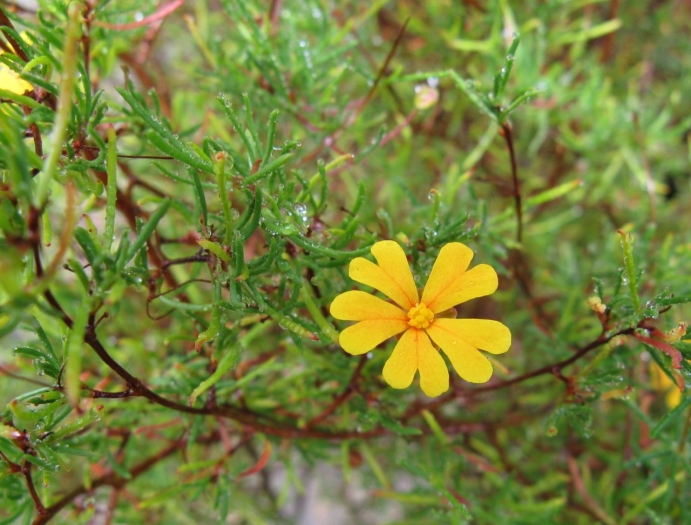Star Guinea Flower
(Hibbertia stellaris)
Star Guinea Flower (Hibbertia stellaris)
/
/

Nadiatalent
CC BY-SA 3.0
Image By:
Nadiatalent
Recorded By:
Copyright:
CC BY-SA 3.0
Copyright Notice:
Photo by: Nadiatalent | License Type: CC BY-SA 3.0 | License URL: https://creativecommons.org/licenses/by-sa/3.0 | Uploader: Nadiatalent | Publisher: Wikimedia Commons | Title: Hibbertia_stellaris_1.jpg | Notes: Cross-wiki upload from en.wikipedia.org |
















Estimated Native Range
Summary
Hibbertia stellaris, commonly known as Star Guinea Flower, is an evergreen shrub native to the sandy soils and coastal heathlands of Southwestern Australia. This plant typically grows to a height of 30–70 cm and spreads 30–60 cm wide. The stems can exhibit a red tinge, adding to its ornamental value. Star Guinea Flower is renowned for its vibrant orange to yellowish flowers that bloom from August to February, with the color intensity varying by geographic location. The flowers are particularly showy, making it a popular choice for gardeners.
The Star Guinea Flower is valued for its striking floral display and is often used in rockeries, native plant gardens, and as a container plant due to its adaptability to pot culture. It is relatively easy to maintain but is known to be short-lived when planted in the ground, often treated as an annual due to its lifespan of around 18 months. However, it can survive longer in containers. The plant is moderately frost-tolerant and prefers acidic, sandy soils with good drainage. It thrives in full sun, which encourages more abundant flowering, but this can also shorten its lifespan. Propagation is straightforward from cuttings taken in spring post-flowering. It requires medium watering and is best situated in an area that mimics its natural habitat, such as raised beds or sandy substrates that provide consistent moisture without waterlogging.CC BY-SA 4.0
The Star Guinea Flower is valued for its striking floral display and is often used in rockeries, native plant gardens, and as a container plant due to its adaptability to pot culture. It is relatively easy to maintain but is known to be short-lived when planted in the ground, often treated as an annual due to its lifespan of around 18 months. However, it can survive longer in containers. The plant is moderately frost-tolerant and prefers acidic, sandy soils with good drainage. It thrives in full sun, which encourages more abundant flowering, but this can also shorten its lifespan. Propagation is straightforward from cuttings taken in spring post-flowering. It requires medium watering and is best situated in an area that mimics its natural habitat, such as raised beds or sandy substrates that provide consistent moisture without waterlogging.CC BY-SA 4.0
Plant Description
- Plant Type: Shrub
- Height: 1-2.5 feet
- Width: 1-2 feet
- Growth Rate: Moderate
- Flower Color: Orange
- Flowering Season: Spring
- Leaf Retention: Evergreen
Growth Requirements
- Sun: Full Sun, Part Shade
- Water: Medium
- Drainage: Fast
Common Uses
Bee Garden, Butterfly Garden, Drought Tolerant, Low Maintenance, Rock Garden, Showy Flowers
Natural Habitat
Sandy soils and coastal heathlands of Southwestern Australia
Other Names
Common Names: Orange Stars
Scientific Names: , Hibbertia stellaris, Hibbertia tenuiramea,
GBIF Accepted Name: Hibbertia stellaris Endl.